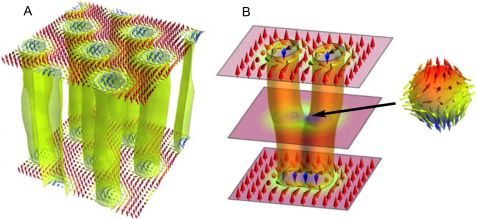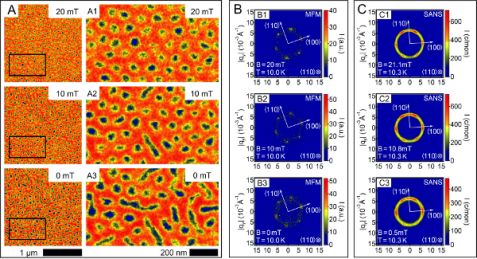MLZ ist eine Kooperation aus:
 > Technische Universität München
> Technische Universität München > Helmholtz-Zentrum Hereon
> Helmholtz-Zentrum Hereon
 > Forschungszentrum Jülich
> Forschungszentrum Jülich
MLZ ist Mitglied in:
 > LENS
> LENS > ERF-AISBL
> ERF-AISBL
MLZ in den sozialen Medien:

MLZ
Lichtenbergstr.1
85748 Garching
Topological unwinding of a Skyrmion lattice by magnetic monopoles
P. Milde1, D. Köhler1, J. Seidel2, L. M. Eng1, A. Bauer3, A. Chacon3, J . Kindervater3, S. Mühlbauer4, C. Pfleiderer3, S. Buhrandt5, C. Schütte5, and A. Rosch5
1Institut für Angewandte Photophysik, Technische Universität Dresden, Dresden, Germany
2School of Materials Science and Engineering, University of New South Wales, Sydney, Australia
3Physik-Department E21, Technische Universität München, Garching, Germany
4Heinz Maier-Leibnitz Zentrum (MLZ), Technische Universität München, Garching, Germany
5Institut für Theoretische Physik, Universität zu Köln, Köln, Germany
Skyrmion lattices in chiral magnets can be regarded as macroscopic lattices formed by topological entities with particle-like properties where the particle-like character of the Skyrmions is reflected in the integer winding number of their magnetization. Due to their topology, Skyrmions cannot be destroyed or created by smooth deformation of a trivial spin texture. We use magnetic force microscopy in combination with numerical simulations and small angle neutron scattering to study the topological unwinding of Skyrmion lines in a bulk crystal of Fe1-xCoxSi (x = 0.5). Our study shows that the Skyrmion lines decay by means of point defects which act in a way similar to the slider of a zipper. We show that these point defects can be regarded as quantized magnetic monopoles of emergent magnetic flux [1].
Skyrmions: Topological protection & particle-like properties
Two objects or configurations are topologically different (they belong to a different homotopy group) if there exists no continuous transformation of one configuration into the other without cutting or gluing [2]. The same applies to Skyrmions: The concept goes back to Tony Skyrme, who succeeded in describing the constituents of the nucleus – protons and neutrons – as particle-like excitations with non-trivial topology that emerge in the presence of non-linear excitations [3]. Recently, Skyrmionic matter has also been observed in a completely different context: Materials exhibiting helical magnetic structures such as MnSi [4], Fe1-xCoxSi [5] or Cu2OSeO3 [6] show peculiar spin textures with non-trivial topology, characterized by an integer winding number of -1. These Skyrmion lines can be seen as magnetic whirls – akin to vortices in type II superconductors – with particle-like properties, oriented parallel to a small external magnetic field (fig. 1 A). Due to their topology, these magnetic Skyrmions cannot be destroyed or created by a smooth deformation of a trivial spin texture – such as a ferromagnet. A similar idea applies to magnetic domain walls, which are examples of planar topological defects in two dimensions.
Skyrmion lattices – regular crystalline arrangements of Skyrmion lines found in chiral magnets provide an excellent showcase for the investigation of topological stability and phase conversion. We combine magnetic force microscopy (MFM) with numerical Monte Carlo (MC) calculations and small-angle neutron scattering (SANS) [1] to investigate the topological stability and decay of Skyrmions in the B20 helimagnet Fe1-xCoxSi (x = 0.5) [1].
Skyrmion decay in Fe1-xCoxSi (x = 0.5)
With a typical length scale of ≈ 90 nm, the Skyrmion lattice of Fe1-xCoxSi (x = 0.5) is large compared to the resolution of MFM; however the bulk information is still accessible using SANS. Moreover, the possibility of undercooling the Skyrmion lattice phase of Fe1-xCoxSi (x = 0.5) from Tc = 45 K to a metastable state at low temperature allows one to study the generic mechanism of the topological unwinding without the dominating influence of thermal fluctuations close to Tc.
Typical MFM data for different magnetic fields is shown in figure 2(A). Data is recorded after cooling from Tc in a magnetic field of 20 mT to a temperature of 10 K (A1), followed by a magnetic field ramp to 10 mT (A2) and finally 0 mT (A3). The magnetic field is aligned perpendicular to the surface of the sample. It is clearly visible that individual skyrmions (as indicated by the blue spots) form a well-ordered Skyrmion lattice at 20 mT. Decreasing the field in this metastable state leads to a coalescence of Skyrmions which finally form elongated structures. Panels (B) of figure 2 show the corresponding Fourier transforms of the real space MFM data, confirmed by typical SANS patterns obtained on the same sample following an identical magnetic field and temperature protocol (panel ©). The agreement with bulk sensitive SANS data, obtained on SANS-1 at MLZ clearly proves that the surface sensitive MFM captures the essential features of the topological unwinding of Skyrmions in Fe1-xCoxSi (x = 0.5) in this bulk sample.
With the help of classical MC simulations on a 42 × 42 × 30 spin system, the mechanism behind the coalescence of Skyrmion lines could be examined in closer detail. Typical MC data is shown in figure 1 panels A and B. As the field is reduced, transverse fluctuations of the Skyrmion lines grow until individual Skyrmion lines touch and merge. Due to the topological charge or winding number of the Skyrmions, the point of coalescence necessarily carries a quantized emergent magnetic charge which can be interpreted as “emergent magnetic monopole” [1]. Two different processes can be identified: (i) The Skyrmion lines merge at the surface of the sample, an emergent (anti)monopole enters the sample through the surface. (ii) The point of coalescence can be located in the bulk of the sample, corresponding to monopole/ antimonopole pairs moving towards the surface. However, there is a finite linear potential (string tension) holding the monopole and antimonopole pair together. During phase conversion, the string potential vanishes and eventually becomes negative.
As interesting open question remains as to whether deconfined emergent monopoles exist as independent entities in chiral magnets. A promising candidate may be the unconventional non-Fermi liquid properties of MnSi under high pressure [7,8].
References:
[1] P. Milde et al., Science 340, 6136, (2013).
[2] N. Manton et al., Topological Solitons, Cambridge Univ. Press, Cambridge (2004).
[3] T. Skyrme, Nucl. Phys. 31, 556 (1962).
[4] S. Mühlbauer et al., Science 323, 915 (2009).
[5] W. Münzer et al., Phys. Rev. B 81, 041203® (2010).
[6] S. Seki et al., Science 336, 198 (2012).
[7] C. Pfleiderer et al., Nature 414, 427 (2001).
[8] R. Ritz et al., Nature 497, 231 (2013).
MLZ ist eine Kooperation aus:
 > Technische Universität München
> Technische Universität München > Helmholtz-Zentrum Hereon
> Helmholtz-Zentrum Hereon
 > Forschungszentrum Jülich
> Forschungszentrum Jülich
MLZ ist Mitglied in:
 > LENS
> LENS > ERF-AISBL
> ERF-AISBL
MLZ in den sozialen Medien:




